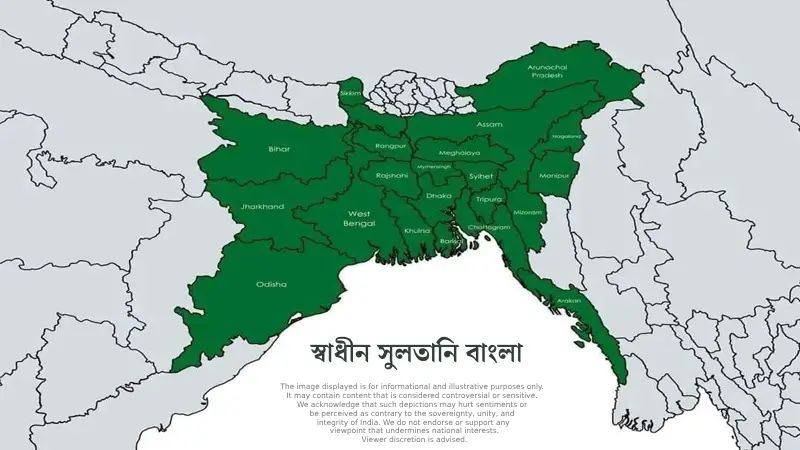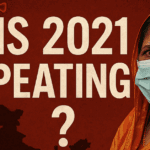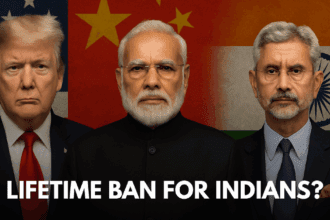The concept of “Saltanat-e-Bangla” or Greater Bangladesh-a contested irredentist ideology envisioning territorial expansion into India’s eastern and northeastern states-has resurfaced in regional discourse amid Bangladesh’s political transformation under interim leader Muhammad Yunus. This report examines the historical roots of the ideology, its contemporary relevance, and the geopolitical ramifications for South Asia. It analyzes Bangladesh’s internal dynamics under Yunus’s leadership, Pakistan’s strategic alignment, India’s security concerns, and the United States’ role in countering regional instability.
Historical Context and Evolution of the Greater Bangladesh Ideology
Origins in Colonial and Post-Colonial Bengal
The territorial aspirations of Greater Bangladesh trace back to the pre-1947 Bengal region, which spanned modern-day Bangladesh and India’s West Bengal, Tripura, and Assam. During British rule, Bengal’s cultural and administrative unity fostered a shared Bengali identity, which persisted even after the 1947 Partition. Post-independence, figures like Maulana Abdul Hamid Khan Bhashani advocated for a unified Bengali homeland, arguing that India’s partition had fractured a cohesive linguistic and cultural entity.
The 1971 Bangladesh Liberation War, which established Bangladesh as an independent nation, initially focused on self-determination rather than territorial expansion. However, by the 1980s, fringe Islamist groups in Bangladesh began reinterpreting the liberation struggle as a stepping stone to reclaiming “lost” Bengali territories in India. These groups, including factions linked to Jamaat-e-Islami, propagated maps depicting northeastern India and parts of West Bengal as part of a “Greater Bangladesh,” often invoking the historical Sultanate of Bengal (13th–16th centuries) as a cultural precedent.

Map of Greater Bangladesh concept
Map illustrating the territorial claims of the Greater Bangladesh ideology, incorporating parts of India and Myanmar.
The Role of Conspiracy Theories and Political Instrumentalization
The Bharatiya Janata Party (BJP) in India has frequently cited the Greater Bangladesh narrative to allege a demographic invasion of Hindu-majority regions by Bengali Muslims. BJP leaders argue that illegal immigration from Bangladesh, coupled with electoral gerrymandering, seeks to Islamize areas like Assam and West Bengal. While academic studies largely dismiss these claims as exaggerated, they have gained traction in Indian domestic politics, fueling anti-Bangladeshi sentiment and justifying stringent border controls.
In December 2024, a Facebook post by Mahfuj Alam, an adviser in Yunus’s interim government, reignited tensions. The post featured a map labeling northeastern India and Myanmar’s Rakhine State as part of Bangladesh, accompanied by calls for a “new geography and system” to liberate suppressed cultures. Though swiftly deleted, the incident drew sharp condemnation from India’s Ministry of External Affairs and underscored the fragility of bilateral relations.
Muhammad Yunus’s Interim Government: A Paradigm Shift in Bangladeshi Politics
From Microfinance Pioneer to Political Lightning Rod
Nobel laureate Muhammad Yunus, appointed Chief Adviser of Bangladesh’s interim government in August 2024, initially symbolized hope for democratic reform following Sheikh Hasina’s ouster. However, his administration has pursued controversial policies, including lifting the ban on Jamaat-e-Islami-a party implicated in war crimes during the 1971 Liberation War-and easing restrictions on Islamist madrasas. Critics argue these moves have emboldened extremist factions, leading to increased attacks on Hindu minorities and Ahmadiyya Muslims.
Yunus’s alignment with Islamist groups contrasts sharply with his earlier reputation as a secular reformer. Analysts suggest this pivot aims to consolidate power by appeasing conservative constituencies, particularly in rural areas where Jamaat-e-Islami retains influence. Concurrently, his government has deepened ties with China and Pakistan, signaling a departure from Hasina’s India-centric foreign policy.
Strategic Reorientation: China and Pakistan as Key Allies
Bangladesh’s tilt toward Beijing and Islamabad has alarmed New Delhi. China has pledged $40 billion in infrastructure investments under the Belt and Road Initiative (BRI), including the construction of a deep-sea port in Cox’s Bazar, which could challenge India’s naval dominance in the Bay of Bengal. Pakistan, meanwhile, has provided tacit support to Yunus’s Islamist agenda, viewing Bangladesh as a strategic counterweight to India in South Asia.
This realignment has economic and ideological dimensions. Pakistan’s Inter-Services Intelligence (ISI) is reportedly facilitating arms transfers to Rohingya insurgent groups in Myanmar, using Bangladesh as a transit route. Such activities risk destabilizing India’s northeastern states, where ethnic separatist movements remain active.
India’s Security Concerns and Strategic Countermeasures
Border Vulnerabilities and Demographic Pressures
India shares a 4,096-kilometer border with Bangladesh, traversing West Bengal, Assam, Tripura, Meghalaya, and Mizoram. Despite fencing and surveillance systems, smuggling networks and illegal immigration persist. Indian intelligence agencies estimate that 15–20 million Bangladeshis reside illegally in India, with concentrations in Assam and West Bengal. While most migrants seek economic opportunities, the BJP frames this influx as a deliberate strategy to alter demography and advance Greater Bangladesh ambitions.

Map of Greater Bangladesh concept
Map highlighting the India-Bangladesh border regions, including vulnerable enclaves and disputed territories.
The China-Pakistan-Bangladesh Axis: A Tripartite Challenge
India perceives the Yunus government’s partnerships with China and Pakistan as a direct threat to its regional influence. Key concerns include:
- Military Encroachment: China’s presence in Cox’s Bazar could enable dual-use infrastructure for naval operations, complicating India’s access to the Malacca Strait.
- Islamist Radicalization: Pakistan-backed groups like Lashkar-e-Taiba (LeT) are exploiting Bangladesh’s political instability to establish sleeper cells in West Bengal and Assam.
- Territorial Claims: The proliferation of Greater Bangladesh maps in Bangladeshi universities, often disseminated by Turkish and Malaysian NGOs, has intensified fears of irredentist mobilization.
India’s Response: Multifaceted Deterrence
To counter these threats, India has adopted a three-pronged strategy:
- Enhanced Border Security: The Border Security Force (BSF) has deployed drone surveillance and smart fencing along high-traffic zones. In 2024, India allocated $1.2 billion to modernize border infrastructure, including the installation of thermal imaging cameras.
- Diplomatic Outreach: New Delhi is engaging with moderate Bangladeshi civil society groups and opposition leaders to counterbalance Yunus’s Islamist allies. Initiatives like the “Digital Bangladesh” partnership aim to bolster tech collaboration and reduce Dhaka’s reliance on Chinese investment.
- Regional Alliances: India is strengthening ties with the Quad (US, Japan, Australia) and ASEAN to isolate China’s influence. Joint naval exercises with the US in the Bay of Bengal signal a commitment to upholding maritime security.
Pakistan’s Strategic Calculus: Reviving Historical Ties
From Rivalry to Reconciliation
Despite Bangladesh’s independence from Pakistan in 1971, Islamabad has sought to rehabilitate relations under Yunus. Pakistan’s Foreign Minister, Bilawal Bhutto Zardari, praised Yunus’s “progressive Islamic governance” during a 2025 visit to Dhaka, announcing $500 million in aid for madrasa reforms. This overture aligns with Pakistan’s broader goal of cultivating Islamist allies to counter India’s regional hegemony.
Exploiting Ethnic and Religious Fault Lines
Pakistan’s ISI has reportedly intensified support for Rohingya insurgent groups, such as the Arakan Rohingya Salvation Army (ARSA), operating from Bangladeshi refugee camps. By fueling instability in Myanmar’s Rakhine State, Pakistan aims to divert India’s military resources away from Kashmir. Additionally, ISI-backed propaganda networks are amplifying anti-India narratives on Bangladeshi social media, framing New Delhi as an oppressor of Bengali Muslims.
The United States’ Dilemma: Balancing Democracy and Security
From Democracy Promotion to Damage Control
The US initially welcomed Yunus’s appointment, viewing him as a reformer who could stabilize Bangladesh’s fractured democracy. However, his tolerance of Islamist groups has prompted reassessment. In April 2025, the State Department condemned a spike in communal violence, urging Yunus to protect religious minorities and curb hate speech.
Countering Chinese Influence
Washington remains wary of Bangladesh’s deepening ties with China. The US Millennium Challenge Corporation (MCC) has offered $2 billion in grants for infrastructure projects, contingent on Dhaka reducing BRI engagement. Simultaneously, the US Indo-Pacific Command has expanded intelligence-sharing with India to monitor Chinese naval activities in the Bay of Bengal.
Conclusion: Navigating a Precarious Regional Balance
The Greater Bangladesh ideology, while marginal in mainstream Bangladeshi politics, has gained symbolic resonance under Yunus’s interim government. Its convergence with Islamist radicalization and Sino-Pakistani strategic interests poses a multifaceted challenge to India’s security architecture. New Delhi’s response-combining border hardening, diplomatic engagement, and Quad collaboration-reflects the urgency of containing regional instability.
For the United States, the dilemma lies in balancing democratic values with realpolitik. Supporting Bangladesh’s economic development while countering Chinese encroachment requires nuanced diplomacy. As Yunus navigates competing pressures from domestic conservatives and international stakeholders, the specter of “Saltanat-e-Bangla” will continue to shape South Asia’s geopolitical trajectory.









